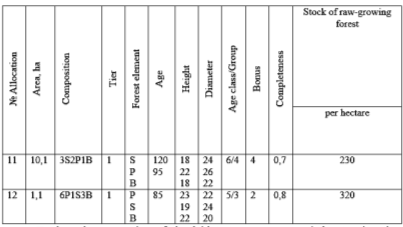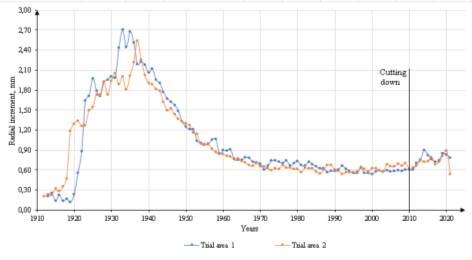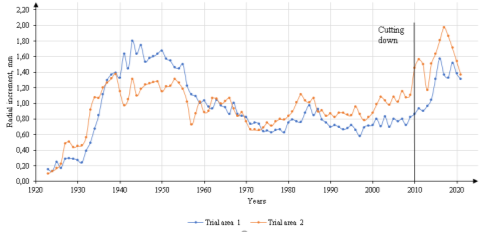Radial growth of conifers in the areas of voluntary selective logging in the North-taiga district of the Arkhangelsk region
Авторы: Молчанова Лариса Ивановна, Ханталина Мария Александровна
Рубрика: 31. Прочее
Опубликовано в
LIX международная научная конференция «Исследования молодых ученых» (Казань, апрель 2023)
Дата публикации: 21.04.2023
Статья просмотрена: 4 раза
Библиографическое описание:
Молчанова, Л. И. Radial growth of conifers in the areas of voluntary selective logging in the North-taiga district of the Arkhangelsk region / Л. И. Молчанова, М. А. Ханталина. — Текст : непосредственный // Исследования молодых ученых : материалы LIX Междунар. науч. конф. (г. Казань, апрель 2023 г.). — Казань : Молодой ученый, 2023. — С. 116-121. — URL: https://moluch.ru/conf/stud/archive/488/17935/ (дата обращения: 30.04.2024).
In the article, the authors considered the impact of voluntary selective logging on the remaining stand after logging in the North Taiga district of the Arkhangelsk region.
Keywords: radial growth, voluntary selective felling, care felling, renewal of undergrowth, forest.
1. Introduction
For many years, continuous logging has been carried out in the European North. It is precisely because of intensive logging that the areas with ripe coniferous forests have been greatly reduced. Basically, the seeds of coniferous species (spruce) occur on deciduous trees, which are less valuable for harvesting.
The safety of the undergrowth is interrelated with the technology by which logging operations are carried out. That is why, to ensure the natural renewal of conifers, it is necessary to use the correct types of logging and the optimal technology of logging operations [1].
In this study, selective logging is considered, namely voluntary-selective. This type of logging is the most gentle for forest planting [5].
The forest fund is used rationally in the process of selective logging. Over-standing, fauteous and dry trees are removed first. Also, a part of ripe trees that have weakened growth and lost the quality of business wood is removed. Trees that have not reached the age of ripeness and are partially larger, but growing well, are left. Also, the entire undergrowth of conifers is left. The method of artificial forest restoration comes to naught in this case.
Voluntary selective logging is one of the types of selective logging. They are held in stands of different ages.
The purpose of this study is to test the effectiveness of care felling, as well as the success of forest renewal (emergence of undergrowth) after these felling, on two trial areas in different types of forests of the Arkhangelsk region of the Plesetsk district.
2. Material and methods
2.1. Study area
The research was carried out in the Priozerny forestry of the Plesetsk district, Arkhangelsk region, namely in the Konevsky district forestry, block 64, allotments 11 and 12.
Priozernoye forestry is located in the west of the central part Arkhangelsk region within the Plesetsk administrative district, the center of which is the urban-type settlement of Plesetsk. The forestry office is located in the village of Konevo. The total area of the forestry is 891553 hectares. The length of the forestry territory from north to south is 110 km, from west to east — 140 km.
2.2. Study design
Felling of trees at the site of voluntary selective logging was carried out in winter with the help of chainsaws, skidding — with a tractor TDT-55. The cutting looked well-groomed and without unnecessary felling residues. This happened due to the fact that the cutting was carried out manually, using chainsaws [2]. At the place of wood removal, the roads were compacted with the help of branches (felling residues) so that the road grew dense. The road suffered less from the tractor and the stakes were not formed, thanks to such flooring, especially in swampy areas [3].
The collection of the material used for the study was carried out in the summer of 2021 on 2 test areas, which were laid according to OST 56–69–83 [4]. The trial areas were laid in the types of forests longmose spruce and blueberry pine.
The re-selection of trees was carried out on trial areas. Quality categories of shelf life, diameters and heights have been established. The cores were taken at each test area at the root neck using an age drill. Heights and diameters were measured at chest height (1.3 m). These materials were collected in order to assess the growth of wood after voluntary selective logging carried out in 2010. Cores were taken 20 pieces for pine and 10 pieces for spruce, on each test area.
2.3. Data collection
Before proceeding to the study in the Priozerny forestry, the data on the voluntary selective logging were obtained. The data is provided in the form of a taxational description of the trial areas, prior to voluntary selective logging (Fig.1).

Fig. 1. Tax description of allotments before logging
Further, the processing of the laid test areas was carried out using the finished technology. The heights and diameters of the selected trees were measured, cores were also drilled. The ground cover and undergrowth were studied at 25 sites of 1 *1 meter. All data was entered in the statements.
Next, statistical data processing was carried out in the audience. For this purpose, a device such as the CORIM Maxi core sample meter was used. Thanks to this device, data on late and early wood were obtained. With the help of it, it was possible to track how much the growth of wood increased after voluntary selective logging. The information received was processed using Excel and statistics programs.
3. Results and Discussion
To see the effectiveness of care felling and forest renewal after these felling we analysed two cutting plots with different forest types (forests longmose spruce and blueberry pine) in Plesetsky district of Arkhangelsk region, Russia.The results of the analysis were presented in tables and figures (Table 1, Figure 1 and 2).
Table 1
Results of comparison of increments by species before and after logging
|
Region |
Average growth for the period from 1999 to 2009, mm |
Average growth for the period from 2011 to 2021, mm |
|
By the pine tree |
||
|
Trialarea 1 |
0,58 |
0,80 |
|
Trialarea 2 |
0,64 |
0,74 |
|
By spruce |
||
|
Trialarea 1 |
0,76 |
1,16 |
|
Trialarea 2 |
1,02 |
1,57 |
According to the results of the comparison, it can be seen that there is an increase in the average radial gain for all breeds after voluntary selective logging. The increase after cutting increases and positive dynamics is observed (Fig. 2, 3).

Fig/ 2. Graph of all measurements of radial growth in pine

Fig. 3. Graph of all measurements of the radial growth of spruce
There are two lines on each of the graphs. The first one is blue, it indicates the breed data from the first trial area. The second one is red, it indicates the breed data from the second test area. The vertical line on the graphs indicates the year of voluntary selective logging.
According to these graphs, you can see how the growth of wood by species changes over time, this is especially clearly seen in the graph for pine. For a considerable time, the growth on it did not change, was stable and even began to decrease, but after logging, the pine immediately reacted and it is clear that the radial growth began to grow.
According to the information provided above, there is a positive dynamics of data in the graphs. This is possible only if the logging has had a beneficial effect on the remaining stand.
In order to maintain the positive effect of voluntary selective logging, it is necessary to monitor the dynamics occurring in the stand. After a certain period of time, the indicators will fall, it is at this moment that other methods of voluntary selective logging should be carried out.
The only caveat is that you need to monitor the percentage of the intensity of logging, otherwise it can have a bad effect on the stand and lead to the collapse of plantings and loss of technical properties of wood in plantings.
4. Conclusion
Voluntary selective logging in the Arkhangelsk region, Plesetsk district on the forest areas of the Priozerny forestry showed prospects for increasing the growth of the stand and the safety of harvesting wood using this method of cutting.
As part of this study, we evaluated the wood growth data collected on two sample areas in different types of forest to understand the impact on the stand of voluntary selective logging. Achieving the high performance standards required by state and federal agencies, as well as external third-party sustainability certification requires understanding, as well as improving the potential negative consequences for the felled stand and its long-term productivity. Thus, the assessment of the collected data, such as the radial growth of wood, is of great importance for the sustainable reproduction of woodlands. Our research has shown that due to voluntary selective logging, the growth of wood increases, which shows its effectiveness.
The study will not end at this point, there is still a lot of material (measurements, observation results etc.) which can be considered in this direction and can help assess the impact of voluntary selective logging from other sides.
References:
- Antobre O. O. Forest recovery on skid trails and felling gaps following post-decadal selective logging in a moist semi-deciduous forest in Ghana / O. O. Antobre, A. D. Gyamfi, W. A. Asante, C. A. Nsor, B. Kyereh // Trees, Forests and People — 2021. — № 6. — pp. 1–15.
- Magagnotti, N. Site impact after motor-manual and mechanised thinning in Mediterranean pine plantations / N. Magagnotti, R. Spinelli, O. Guldner, J. Erler // Biosystems Engineering– 2012. — № 2. — pp. 140–147.
- Poltorak B. J. Soil displacement during ground-based mechanized forest operations using mixed-wood brush mats / B. J. Poltoraka, E. R. Labelleb, D. Jaegerc // Soil & Tillage Research — 2018. — № 179. — pp. 96–104.
- Sukhoi, V. I. Trial forest management areas. Bookmark method OST 5 6–6 9–8 3 / V. I. Sukhoi, Yu. A. Kukuev, A. N. Shulgin, V. D. Senko. — USSR State Committee on Forestry — 1983. — pp. 1–59.
- Il'intsev, A. S. The Effect of Voluntary-Selective Felling on the Basic Wood Increment in the Aged Spruce Forests / A. S. Il'intsev, S. V. Tret'yakov, R. A. Ershov, I. V. Fedotov. — News of higher educational institutions. Forest Magazine — 2017. — pp. 95–103.











